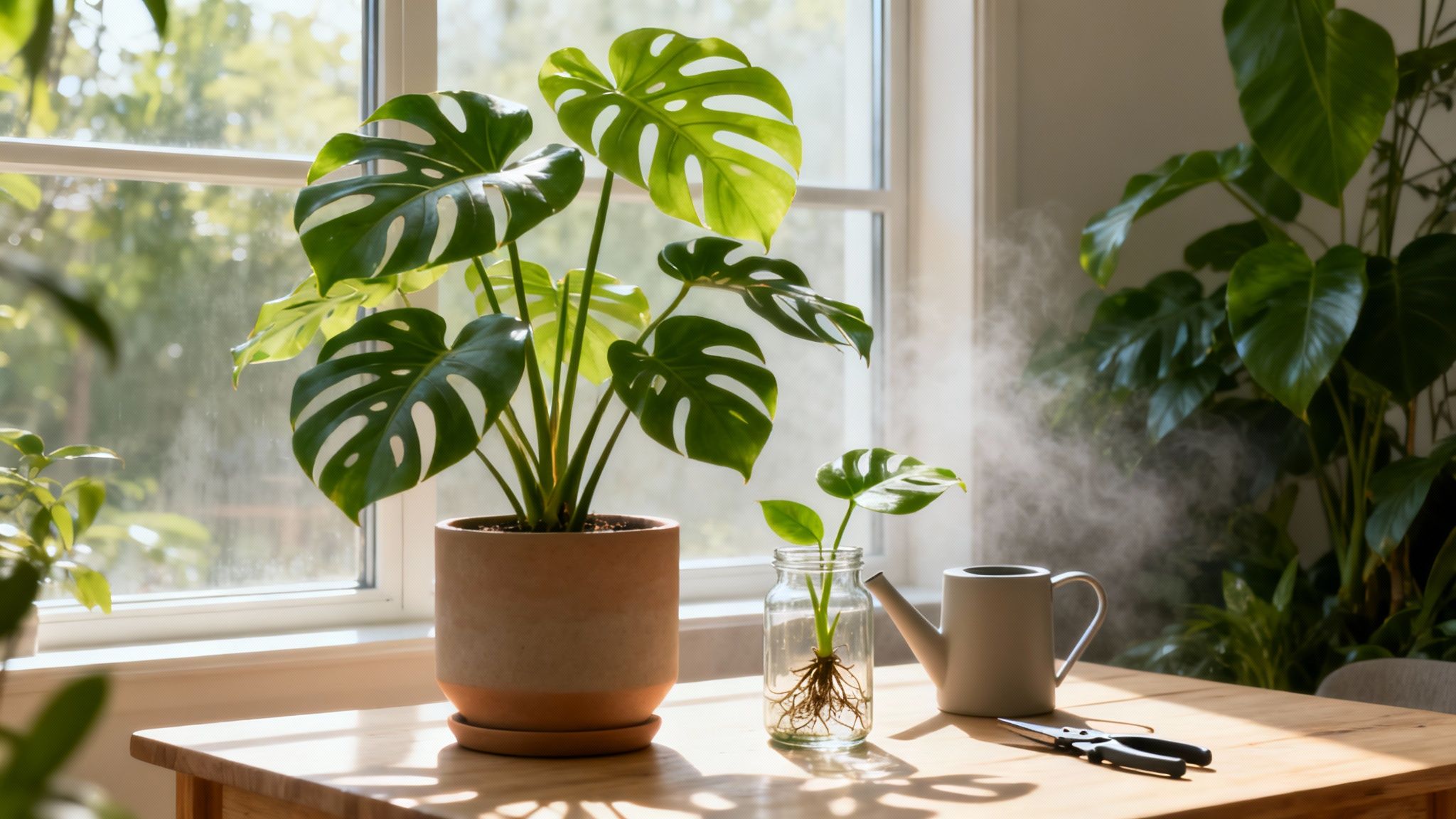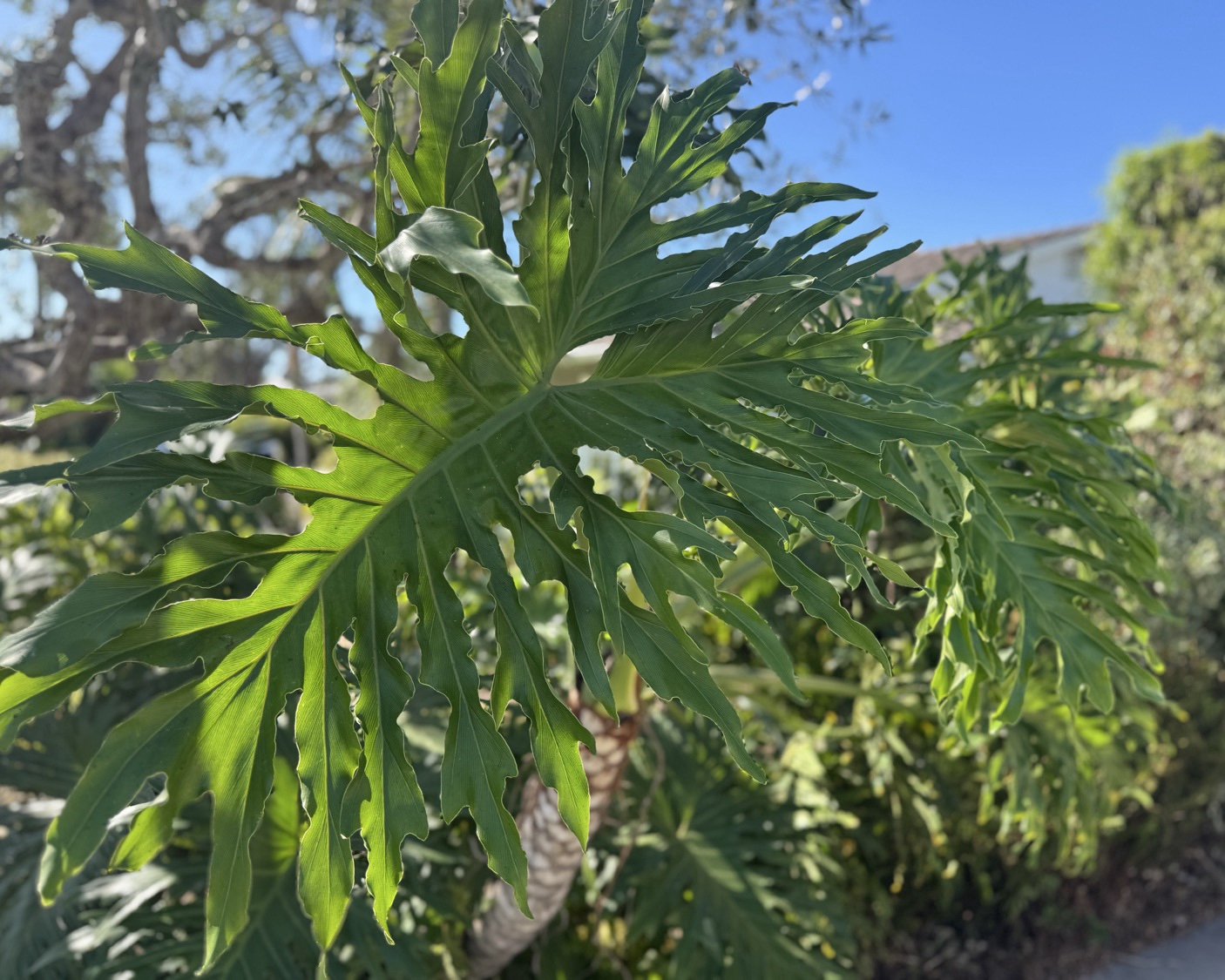Have you ever stared at your Monstera deliciosa, wondering why its leaves aren't splitting or why a new leaf is stubbornly turning yellow? You’re not alone. For a happy Monstera deliciosa, it really comes down to three things: giving it plenty of bright, indirect light, watering only when the top 2-3 inches (5-7 cm) of soil have dried out, and planting it in a chunky, airy soil mix. If you can nail these fundamentals, you’re well on your way to growing a stunning plant with those iconic split leaves. This guide will show you how.
Your Guide to a Thriving Monstera Deliciosa
If you've scrolled through plant posts online, you've probably seen a dozen different opinions on how to care for a Monstera deliciosa (Monstera deliciosa). Let's cut through that noise and focus on what actually works. Affectionately called the 'Swiss Cheese Plant' for its beautifully fenestrated leaves, this tropical stunner is a centerpiece in any room. But its fame isn't just about good looks. The Monstera is also surprisingly forgiving, making it a fantastic plant whether you're a beginner or have been growing for years.
This guide is your complete playbook, starting from the ground up. We'll cover everything from getting the light, water, and soil right from day one, to the more exciting stuff like encouraging those famous leaf splits and even making new plants. Keeping track of a new plant’s needs can feel like a lot at first, but you don't have to wing it. When life gets busy, a little help goes a long way. That's where an app like Tendra and its Smart Care Reminders can be a game-changer. You can set up a personalized schedule right in the app, ensuring your Monstera gets the consistent care it needs to flourish. It takes the guesswork out of your routine so you can just enjoy the view.
What You'll Discover Inside
Think of this as your roadmap to becoming a confident Monstera parent. Here’s what we’ll get into:
Core Essentials: We'll break down what "bright, indirect light" really looks like in your home and share a foolproof way to know exactly when to water.
The Perfect Foundation: I’ll show you how to mix the ideal chunky soil that keeps roots healthy and happy, preventing the dreaded root rot.
Shaping and Sharing: You'll get step-by-step guidance on how to prune your Monstera to keep it looking its best and how to propagate cuttings to share with friends.
Troubleshooting 101: We’ll tackle common issues like yellowing leaves and unwelcome pests, so you can catch problems before they get out of hand.
Before we dive deep, here's a quick cheat sheet covering the essentials. Keep this handy for a speedy reminder of what your Monstera needs to thrive.
Monstera Deliciosa Quick Care Reference
| Care Aspect | Optimal Condition |
|---|---|
| Light | Bright, indirect sunlight (e.g., near an east-facing window). |
| Watering | Water when top 2-3 inches (5-7 cm) of soil feel dry. |
| Soil | Chunky, well-draining aroid mix (orchid bark, perlite, peat). |
| Humidity | Prefers 40-60%, but adaptable to average home humidity. |
| Fertilizer | Balanced liquid fertilizer, diluted, during the growing season. |
| Temperature | 65-85°F (18-29°C); avoid drafts and sudden drops. |
This table gives you the at-a-glance basics, but the real magic is in the details. In the following sections, we'll explore each of these points more thoroughly.
Getting Light and Water Right for Your Monstera Deliciosa Care
If there are two things you absolutely need to nail for your Monstera deliciosa, it's light and water. Think of them as the foundation for a healthy plant. Get these right, and your Monstera will reward you with those big, beautiful, split leaves we all love. Mess them up, and well... everything else becomes an uphill battle.
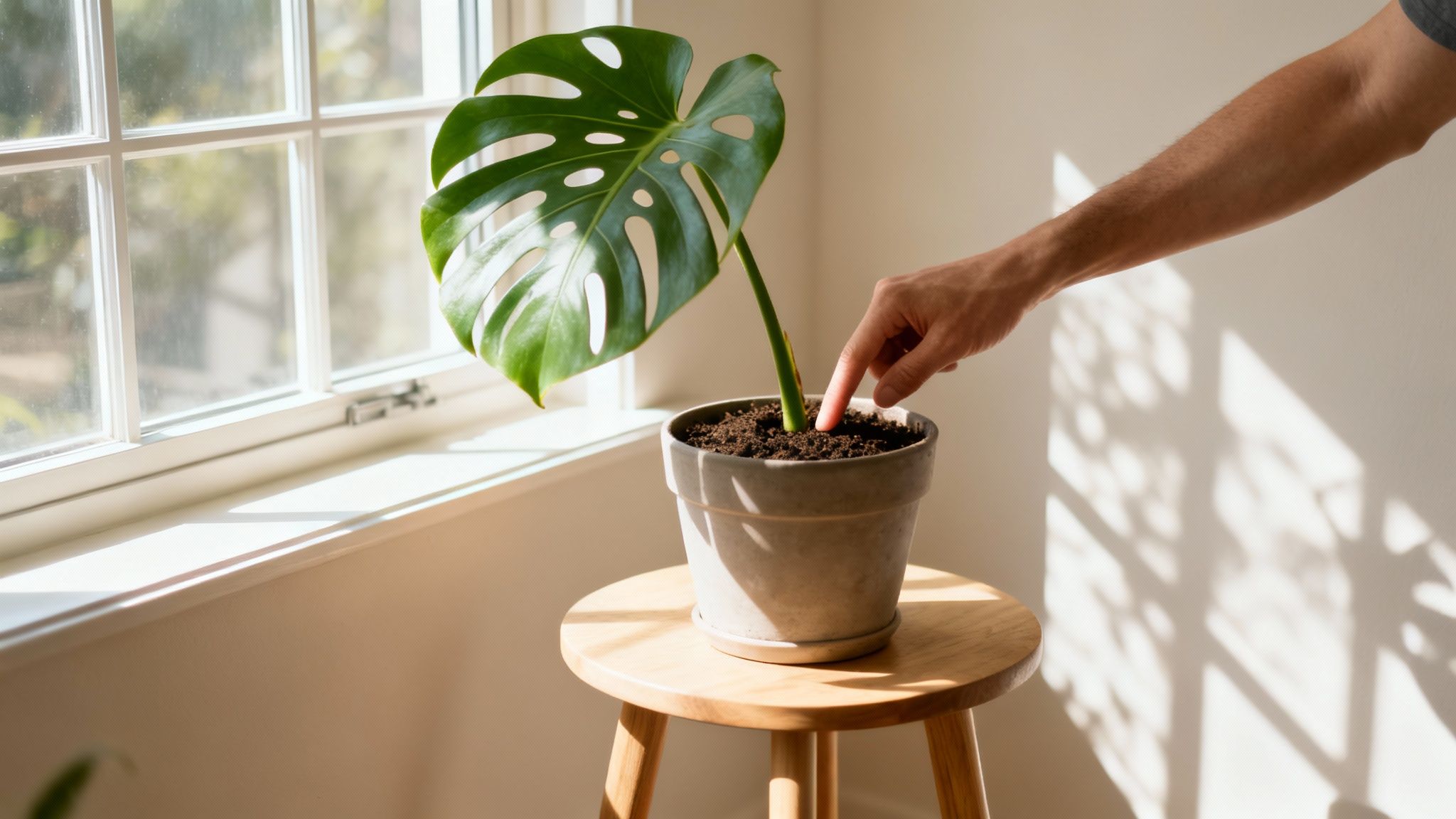 Monstera deliciosa plant with split leaves in a well-lit room.">
Monstera deliciosa plant with split leaves in a well-lit room.">
Decoding Bright Indirect Light
"Bright, indirect light" might be the most common phrase in the houseplant world, and it's also one of the most confusing. What does it actually mean? Just picture your Monstera in its native habitat: the jungle floor. It's not getting blasted by the sun directly. Instead, it's basking in the dappled light filtering down through the canopy. That's the vibe you're going for.
In your home, this sweet spot is often:
A few feet back from a south- or west-facing window, just out of the direct sunbeams.
Right in an east-facing window, where it can soak up the gentle morning sun.
Near a window that has a sheer curtain or a big tree outside to soften the light.
Your Monstera is pretty good at telling you what it needs. If you see scorched, brown, or crispy spots, it’s getting a sunburn from too much direct light. On the flip side, a "leggy" plant with long, stretched-out stems and small, solid leaves is desperately reaching for more light. Those famous splits (fenestrations) only show up when a mature plant has enough energy, which comes directly from getting the right amount of light.
Mastering the Art of Watering
When it comes to water, forget a rigid schedule. Your goal is to be responsive, not robotic. Honestly, the number one mistake I see new plant parents make is killing their plants with kindness—by watering way too often.
It's a surprising fact, but overwatering is the leading cause of death for houseplants. For a Monstera, this might mean watering every 1-2 weeks, but that can change in a heartbeat depending on the season, your home's humidity, and how much light it's getting. For more tips on the basics, you can find a ton of helpful insights about essential Monstera care at Nursery Near Me.
The best way to know if it's time to water? The finger test. It's old-school, but it works. Stick your finger about 2 inches (5 cm) into the soil. If it feels dry down there, go ahead and water. If you feel any moisture at all, give it a few more days and check again. This simple habit is your best defense against root rot, the silent killer that thrives in soggy soil.
Pro Tip: Many seasoned growers swear by using filtered or distilled water. Tap water often has minerals like chlorine and fluoride that can build up in the soil over time and cause those dreaded brown, crispy leaf edges.
A Seasonal Approach to Watering
Your Monstera doesn't need the same amount of water year-round. During the spring and summer, it's in full-on growth mode, pushing out new leaves left and right. It's thirsty! You'll probably find yourself watering it about once a week.
But when fall and winter roll around, the plant's growth slows to a crawl. It enters a sort of dormancy. During this time, you have to cut back on watering. The soil stays damp for much longer, and sticking to a summer schedule is a fast track to root rot. For most people, this means watering only every two or three weeks. Adjusting your routine with the seasons is a massive part of successful Monstera deliciosa care.
Building the Perfect Foundation with Soil and Fertilizer
A happy Monstera deliciosa starts from the ground up—literally. Getting the soil and feeding schedule right is like building a solid foundation for a house; it supports everything that grows above it. Nail this part, and you’re setting your plant up for the vigorous growth and stunning split leaves you're looking for.
Don't just grab any old bag of potting soil off the shelf. Most standard mixes are too dense and hold onto water for far too long, which is the fastest way to invite root rot. Remember, in their native habitat, they're epiphytes, climbing trees with roots exposed to plenty of air, not suffocating in packed dirt.
Crafting the Perfect Soil Mix
To give your Monstera what it truly wants, you need to recreate that natural environment with a mix that's chunky, airy, and drains like a champ. This is non-negotiable. It ensures the roots get plenty of oxygen and that excess water can escape quickly.
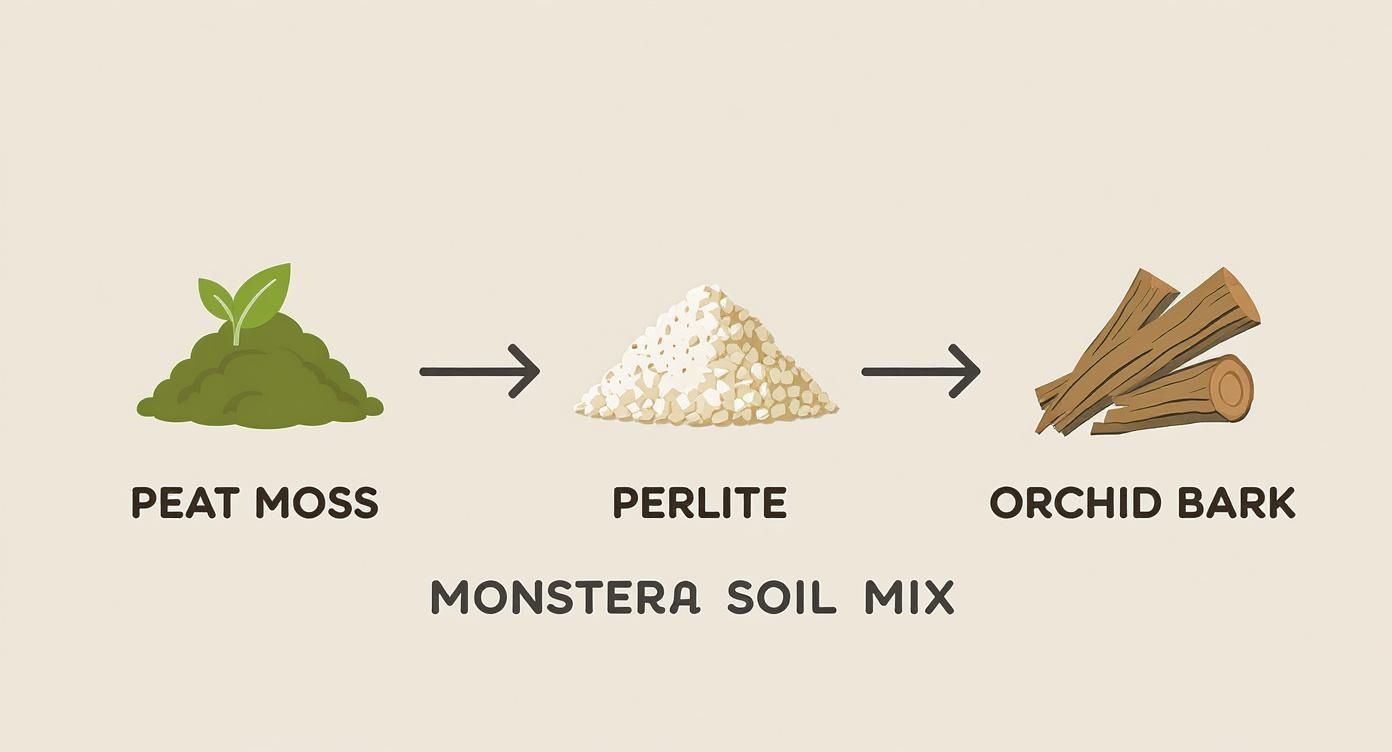
You don't need a degree in soil science to get this right. Here’s a simple, proven DIY recipe that hits the perfect balance of moisture retention and serious aeration:
1 part peat moss or coco coir: This acts as the base, holding just enough moisture and nutrients for the plant to access.
1 part perlite or pumice: These lightweight volcanic rocks are essential for creating air pockets and preventing the mix from ever becoming compacted.
1 part orchid bark: Big, chunky pieces of bark create even more air space and mimic the texture of the tree bark Monsteras naturally cling to.
Just mix these three ingredients together in equal parts. The final blend should feel light and chunky in your hands, a world away from dense, heavy potting soil. This structure is absolutely critical to excellent monstera deliciosa care.
Here's the key takeaway for healthy roots: The right soil is more about what it doesn't hold—excess water—than what it does. A well-aerated mix is your best defense against root problems before they can even start.
A Smart Approach to Fertilizing
Once your Monstera is settled into its perfect soil, it's time to think about food. Fertilizer provides the essential nutrients your plant needs to push out those lush, green leaves and develop its iconic fenestrations. But with fertilizer, more is definitely not better.
The golden rule is to feed your plant only during its active growing season, which is typically spring and summer. This is when it's actively putting out new growth and can actually use the extra fuel. Once fall and winter roll around, growth slows as the plant goes dormant. Fertilizing during this rest period can scorch the roots and do more harm than good. For feeding, a balanced liquid houseplant fertilizer is your best bet. Look for one where the N-P-K numbers (Nitrogen-Phosphorus-Potassium) are relatively even, something like a 10-10-10 or 20-20-20.
Here’s how to do it safely:
Always dilute. Never apply fertilizer at full strength. Dilute it to half the strength recommended on the package instructions.
Water first. Give your plant a good drink of plain water before you fertilize. Applying fertilizer to dry soil can burn the delicate roots.
Be consistent. During the growing season, aim to fertilize every 2-4 weeks. A steady, gentle supply of nutrients is what helps your plant truly thrive.
Getting the nutrient balance right is also tied to the soil's acidity. If you really want to dive deep, you can find a ton of info in our guide to mastering soil pH.
How to Prune, Propagate, and Encourage Leaf Splits
So, your Monstera deliciosa is happy and healthy. Now for the fun part. Eventually, you'll want to shape it or even create new plants to share. This is where pruning and propagation come in—two of the most satisfying parts of owning a Monstera. We’ll also tackle the biggest question everyone asks: how do I get those iconic leaf splits?
Pruning isn’t just about chopping back an overgrown plant. It’s a vital part of keeping it healthy and encouraging a fuller, more balanced shape. Snipping off yellowing or damaged leaves is a great start; it lets your plant focus its energy on new, healthy growth instead of trying to save a failing leaf. You can also trim back any long, unruly vines to keep your plant looking lush and contained.
Getting Hands-On With Propagation
There's something uniquely rewarding about creating a brand-new plant from just a piece of another. For Monsteras, you’ve got two fantastic, tried-and-true methods that work like a charm.
Rooting Stem Cuttings in Water
This is the classic method for a reason—it’s incredibly straightforward, and you get a front-row seat to watch the new roots emerge.
Find Your Node: First, you need to locate a node. Look for a small, bumpy brown ring on the stem. This is where new leaves and aerial roots sprout from. Your cutting must have at least one of these to grow roots.
Make the Cut: Grab a clean, sharp pair of scissors or pruning shears. Make your cut about an inch (2.5 cm) below the node. Make sure your cutting has at least one healthy leaf attached.
Into the Water: Pop the cutting into a glass or jar filled with water. The key is to submerge the node while keeping the leaf completely out of the water. Find it a home with plenty of bright, indirect light.
Wait and Watch: Keep the water fresh by changing it every few days. Before long—usually a few weeks—you’ll spot little white roots starting to sprout. Once they’re a few inches long, your new Monstera is ready for its own pot of soil.
The Mystery of the Split Leaves
And now, for the main event: how do you get those gorgeous, dramatic splits in your Monstera's leaves? Those signature splits, called fenestrations, aren't the result of some secret trick. They're a sign of a happy, mature plant.
Young Monsteras have solid, heart-shaped leaves. It's only as they age and get the right care that they start producing fenestrated leaves. In their native jungle habitat, these splits are thought to help the massive leaves handle strong winds and let dappled sunlight filter through to the lower foliage.
To encourage those beautiful splits, you just need to nail the fundamentals:
Lots of Bright, Indirect Light: This is the most critical factor. A Monstera tucked away in a dim corner will probably never develop splits.
Consistent Watering: A stable watering routine that allows the soil to dry out properly prevents root stress, which is essential for healthy growth.
Good Soil & Nutrients: That chunky, well-draining soil mix and a regular feeding schedule during the growing season provide all the building blocks your plant needs.
Something to Climb: Remember, Monsteras are natural climbers. Giving your plant a moss pole or trellis to latch onto encourages it to mature faster, which leads directly to bigger leaves with more impressive splits.
Achieving fenestrations is the ultimate reward in your monstera deliciosa care journey. It’s your plant's way of telling you that you’ve created a space where it isn't just surviving, but absolutely thriving.
Solving Common Monstera Problems
Even the most seasoned plant parent runs into trouble now and then. Don’t panic. Think of this as your personal troubleshooting guide for the Monstera deliciosa. We'll get to the bottom of common issues and give you clear, practical steps to get your plant happy again.
Diagnosing Yellowing Leaves
Yellow leaves are probably the most common SOS signal a Monstera sends. Nine times out of ten, it’s a watering issue.
Overwatering: If you're seeing yellow leaves, especially the lower, older ones, and the soil feels perpetually damp, you're almost certainly overwatering.
Underwatering: On the flip side, if the leaves are yellowing and drooping, and the soil is bone-dry, your plant is desperately thirsty.
Nutrient Deficiency: Sometimes, if new growth comes in pale, it's a cry for food. This is most common during the spring and summer growing season.
Problem-Solution Scenario: You spot the oldest, lowest leaf on your Monstera turning a solid yellow. Your first thought might be to water it, but you stick a finger in the soil and find it’s still moist a couple of inches down. The fix here is simple: step away from the watering can. Let that soil dry out completely before you water again, and double-check that your pot has good drainage.
For a deeper dive, check out our guide on why your plants are turning yellow.
Dealing with Common Pests
Unfortunately, Monsteras can attract a few uninvited guests. Catching them early is key. Keep an eye out for these culprits.
Spider Mites: Tiny arachnids that create fine, silky webs on the undersides of leaves and a pattern of tiny yellow or white speckles. They love dry conditions.
Mealybugs: Look like little bits of white cotton, usually huddled where leaves meet the stem. They suck the sap out of your plant, which can lead to stunted growth.
If you find pests, isolate the plant immediately. A strong spray of water can knock a lot of them off. For a more stubborn infestation, a thorough spray-down with insecticidal soap or a diluted neem oil solution usually does the trick.
Trying to figure out a weird spot or pest on your own can be stressful. This is where Tendra’s AI Disease Diagnosis tool becomes your best friend. Just snap a photo of the problem area. The app gives you an instant potential diagnosis and a straightforward treatment plan, getting you to the right solution fast.
What About the Rare and Variegated Monsteras?
Once you’ve mastered the classic green Monstera deliciosa, you might start exploring the stunning world of variegated and rare Monsteras. Think of the sought-after Monstera deliciosa ‘Albo Variegata’ with its dramatic splashes of pure white, or the ‘Thai Constellation’ with its creamy, star-like speckles. This beautiful variegation is a genetic mutation, meaning parts of the plant lack chlorophyll.
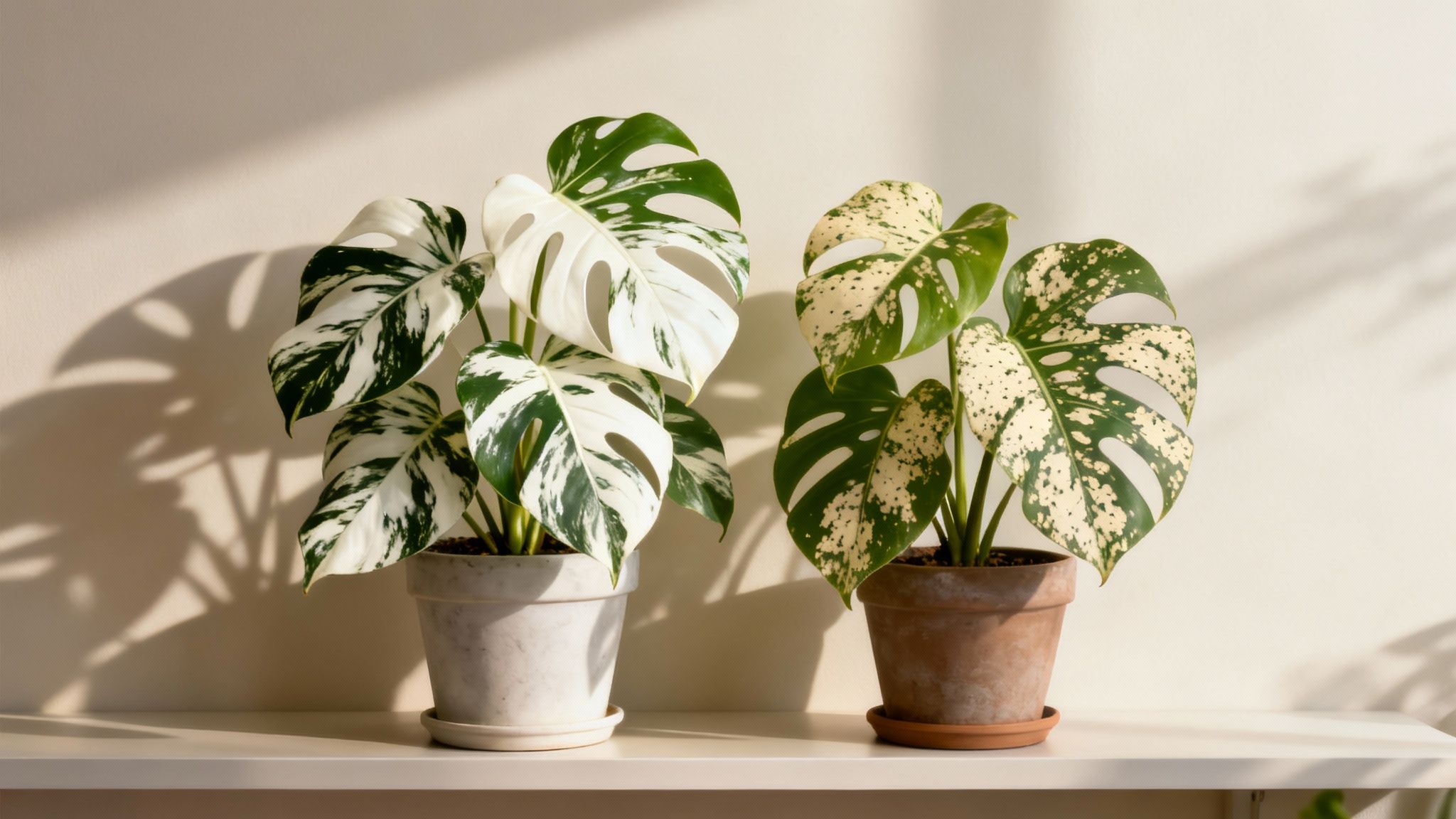 Monstera deliciosa leaf, showing the unique white and green patterns.">
Monstera deliciosa leaf, showing the unique white and green patterns.">
A Different Kind of Care
Because these plants have less chlorophyll, their needs are more demanding.
Finding the Light Sweet Spot: They need much more bright, indirect light than a standard Monstera to make up for the lack of chlorophyll. But be careful—those variegated patches will scorch easily in direct sun.
Embrace the Slow Lane: Don't panic if your variegated Monstera grows at a snail's pace. This is normal.
Water with Caution: Slower growth means they use water more slowly, putting them at a higher risk for overwatering. Always let the soil dry out significantly between waterings.
The rarity and slow propagation of these plants have made them hot commodities. For example, the market for indoor plants has seen a surge in interest in rare varieties, as detailed in reports on market trends and technological impacts and the world of rare and valuable houseplants. Diving into the world of rare plants can feel intimidating, but you don't have to go it alone. This is where a community feature like Tendra's Twin Plant Mates becomes invaluable, connecting you with nearby gardeners growing the same species for hyper-local advice.
Conclusion: Grow Your Monstera with Confidence
Mastering monstera deliciosa care isn't about secret tricks; it's about understanding the fundamentals. By providing the right light, a responsive watering routine, and the perfect chunky soil mix, you give your plant everything it needs not just to survive, but to truly thrive. You've learned how to encourage those stunning split leaves, create new plants through propagation, and troubleshoot the most common problems with confidence. Every yellow leaf or aerial root is just your plant communicating with you, and now you know how to listen.
Growing is always better together. As your Monstera matures, you'll have new questions, and the best answers often come from someone who’s been there before. Discover Tendra's Twin Plant Mates - where local gardeners connect and thrive.
Find your plant's local growing partners with Tendra. https://tendra-app.com
